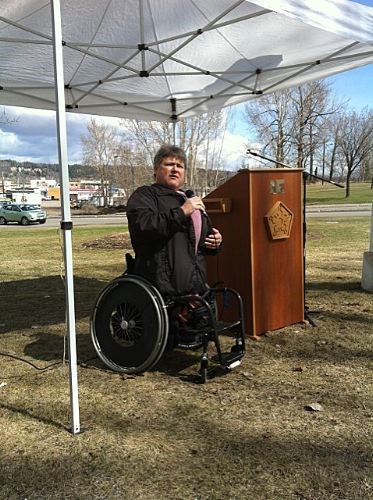Residents and worker safety advocates gathered at a memorial to fallen workers during the national Day of Mourning today.
Speaking to the crowd was Mel Camilli who lost his legs in a work-related accident.
At 21 years old, Camilli had every reason to enjoy life: a well-paying job as a logger, a girlfriend, and hopes for taking over a family forestry business in the future. But in a split second, his world changed.
While doing a routine task at work, he was trapped by a 20-ton piece of machinery, crushing his legs beyond repair. Camilli speaks from his own experience to motivate young workers about the importance of workplace health and safety.
"I knew there were things I would never do, things I would have to learn to do all over again," he says in a advertising for WorkSafeBC. "I resigned myself to never having a girlfriend or a wife. Who'd want to be with a guy like me?"
He found new outlets for physical activity - wheelchair basketball and hockey and he started coaching. Not the type to stay still for long, Camilli also took computer training and is now working for WorkSafeBC. A custom-designed van and his own house keep him independent and active.
Camilli isn't alone in his challenges. Every working day an average of 38 young workers are injured on the job and five of those are permanently injured every week in British Columbia.
In British Columbia last year, 143 workers died and more than 95,600 were injured as a result of work-related injury, illness, or disease. Across Canada, 1,012 workers lost their lives from work-related incidents in 2010.
Of the 143 workplace fatalities in B.C. last year, 68 were traumatic fatalities and 75 were the result of occupational diseases, mainly from exposure to asbestos. The general construction sector recorded the most fatalities overall with 27, followed by 26 in transportation, and 15 in mineral products. Two young workers aged between 15 and 24 were fatally injured in 2010; both as a result of motor vehicle incidents.
The Federation is calling on the provincial government and the Workers' Compensation Board to:
Hire more prevention officers, with a focus on enforcement in high-risk industries
Develop a comprehensive public awareness campaign on workplace and public hazards of exposure to substances such as asbestos, paired with stricter enforcement of the regulations surrounding occupational chemical hazards
Establish a registry of public buildings and workplaces that are known to contain asbestos
Increase criminal prosecutions of employers who willfully ignore worker safety.
WorkSafeBC and Camilli want young workers to realize that workplace accidents can happen in an instant. And the effects can last forever.
He encourages youth to be aware of workplace hazards, to know their rights and responsibilities, and to stay safe and healthy on the job.



